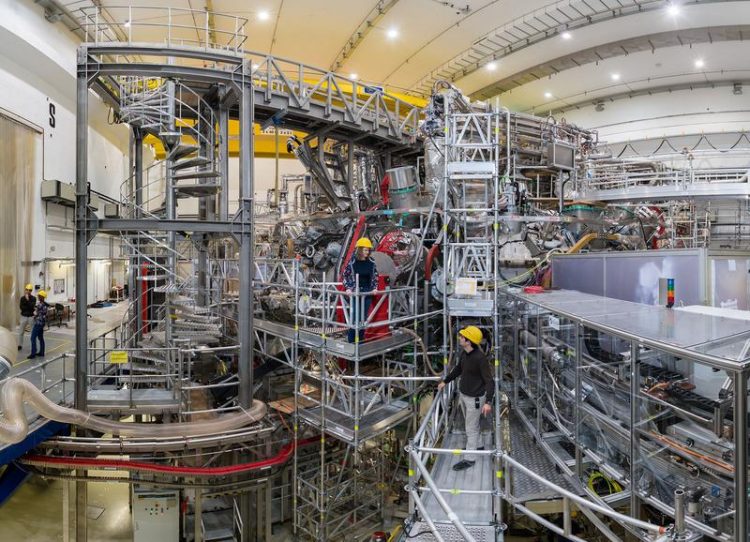Go-ahead for international stellarator project

The Wendelstein 7-X stellarator device in Greifswald Foto: IPP, Volker Steger
The Max Planck Institute for Plasma Physics (IPP) in Greifswald and the U.S. University of Wisconsin-Madison have founded a joint research project to investigate the power exhaust from a hot stellarator plasma. The Helmholtz International Lab for Optimized Advanced Divertors in Stellarators (HILOADS), in which Forschungszentrum Jülich and Auburn University in Alabama also participate, is financially supported by the Helmholtz Association of German Research Centres.
Fusion systems of the stellarator type promise high-performance plasmas in continuous operation. Accordingly, heat and particles from the hot plasma permanently stress the vessel walls.
It is the task of the so-called divertor – a system of specially equipped baffle plates to which the particles from the edge of the plasma are magnetically directed – to regulate the interaction between plasma and wall.
The structure of the magnetic field and the choice of material for the plates determine how well the divertor can perform this task and how well the plasma can be thermally insulated. The divertor design for new stellarators is therefore highly demanding in terms of both plasma physics and technology and requires extensive experimental and theoretical investigations.
For this purpose, IPP in Greifswald and the University of Wisconsin-Madison have now founded the Helmholtz International Lab for Optimized Advanced Divertors in Stellarators (HILOADS).
HILOADS offers the framework to intensify the successful cooperation of the University of Wisconsin in Madison as central institution with IPP in Greifswald, Forschungszentrum Jülich and further US-American universities. The scientists involved will optimise and coordinate divertor designs, materials and plasma confinement.
For the experiments required for this, both Wendelstein 7-X in Greifswald, the world's largest stellarator, and the much smaller but very flexible HSX (Helical Symmetric Experiment) in Madison are available. The two devices differ not only in size, but also in their completely different concepts for the divertor and for optimising plasma confinement.
In addition, there is the small CTH (Compact Toroidal Hybrid) device in Auburn. In addition to these three stellarators, two linear plasma systems will be used for investigations on materials and wall conditioning as well as for the development of measuring instruments: PSI-2 in Jülich and MARIA in Madison. Equipped in this way, HILOADS will promote the development of the next generation of optimised stellarators and, in particular, support the development of a concept for a new medium-sized stellarator experiment in Madison.
With the funding programme of 'Helmholtz International Labs', the Helmholtz Association, to which the IPP is affiliated as an associated institute, aims to expand international cooperation with excellent research institutions and create visible research activities of the Association at locations abroad.
The Helmholtz Association will provide 24 percent of the 6.125 million euros estimated for HILOADS over the next five years. The universities in Madison and Auburn will contribute 35 and 15 percent, respectively, IPP and Forschungszentrum Jülich 18 and 8 percent, respectively. HILOADS is scheduled to start in spring 2020.
Background
The aim of fusion research is to develop an environmentally sound and climate-friendly power plant. Similar to the sun, it will generate energy from the fusion of atomic nuclei. Because the fusion fire only ignites at temperatures above 100 million degrees, the fuel – a low-density hydrogen plasma – must not come into contact with the cold vessel walls. Confined by magnetic fields, it floats almost contact-free inside a vacuum chamber. The Wendelstein 7-X stellarator in Greifswald is intended to investigate the suitability of this type of device for a power plant.
Media Contact
All latest news from the category: Physics and Astronomy
This area deals with the fundamental laws and building blocks of nature and how they interact, the properties and the behavior of matter, and research into space and time and their structures.
innovations-report provides in-depth reports and articles on subjects such as astrophysics, laser technologies, nuclear, quantum, particle and solid-state physics, nanotechnologies, planetary research and findings (Mars, Venus) and developments related to the Hubble Telescope.
Newest articles

Superradiant atoms could push the boundaries of how precisely time can be measured
Superradiant atoms can help us measure time more precisely than ever. In a new study, researchers from the University of Copenhagen present a new method for measuring the time interval,…

Ion thermoelectric conversion devices for near room temperature
The electrode sheet of the thermoelectric device consists of ionic hydrogel, which is sandwiched between the electrodes to form, and the Prussian blue on the electrode undergoes a redox reaction…

Zap Energy achieves 37-million-degree temperatures in a compact device
New publication reports record electron temperatures for a small-scale, sheared-flow-stabilized Z-pinch fusion device. In the nine decades since humans first produced fusion reactions, only a few fusion technologies have demonstrated…





















